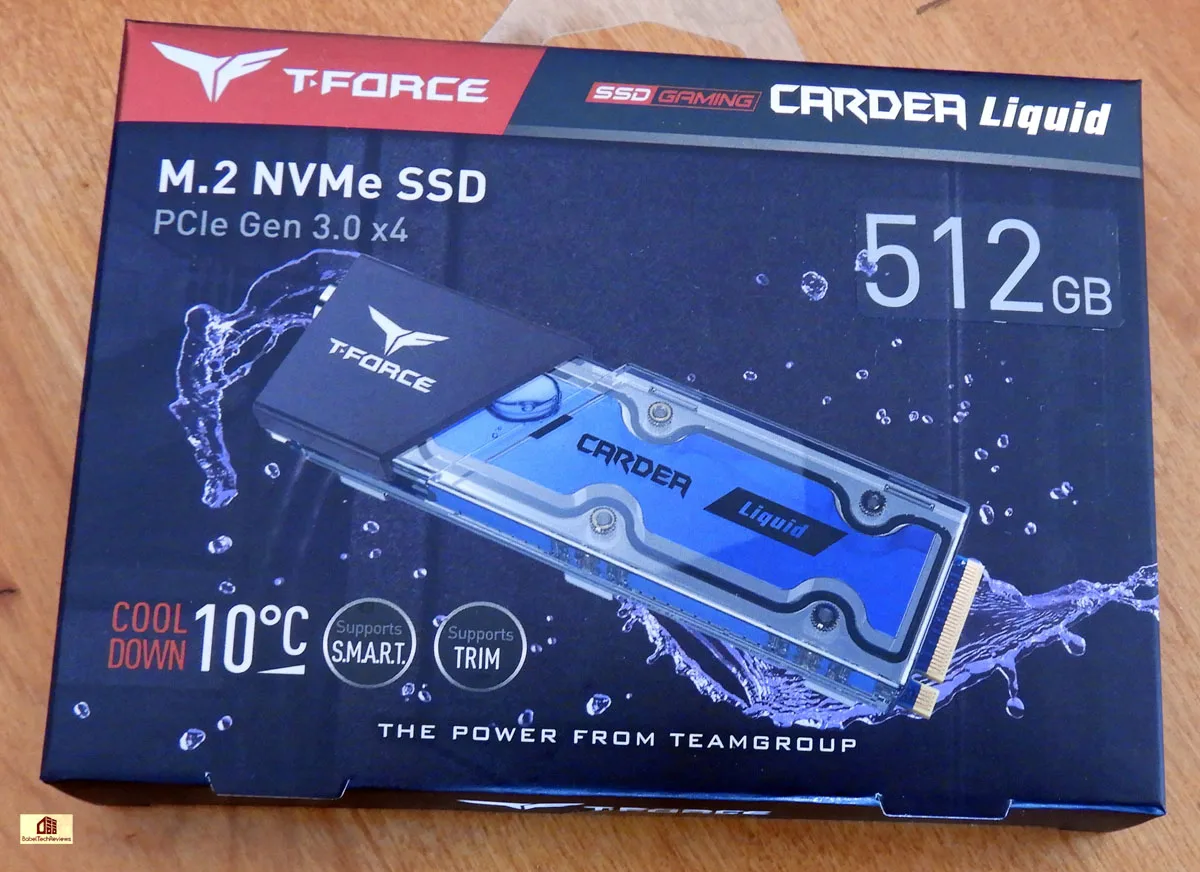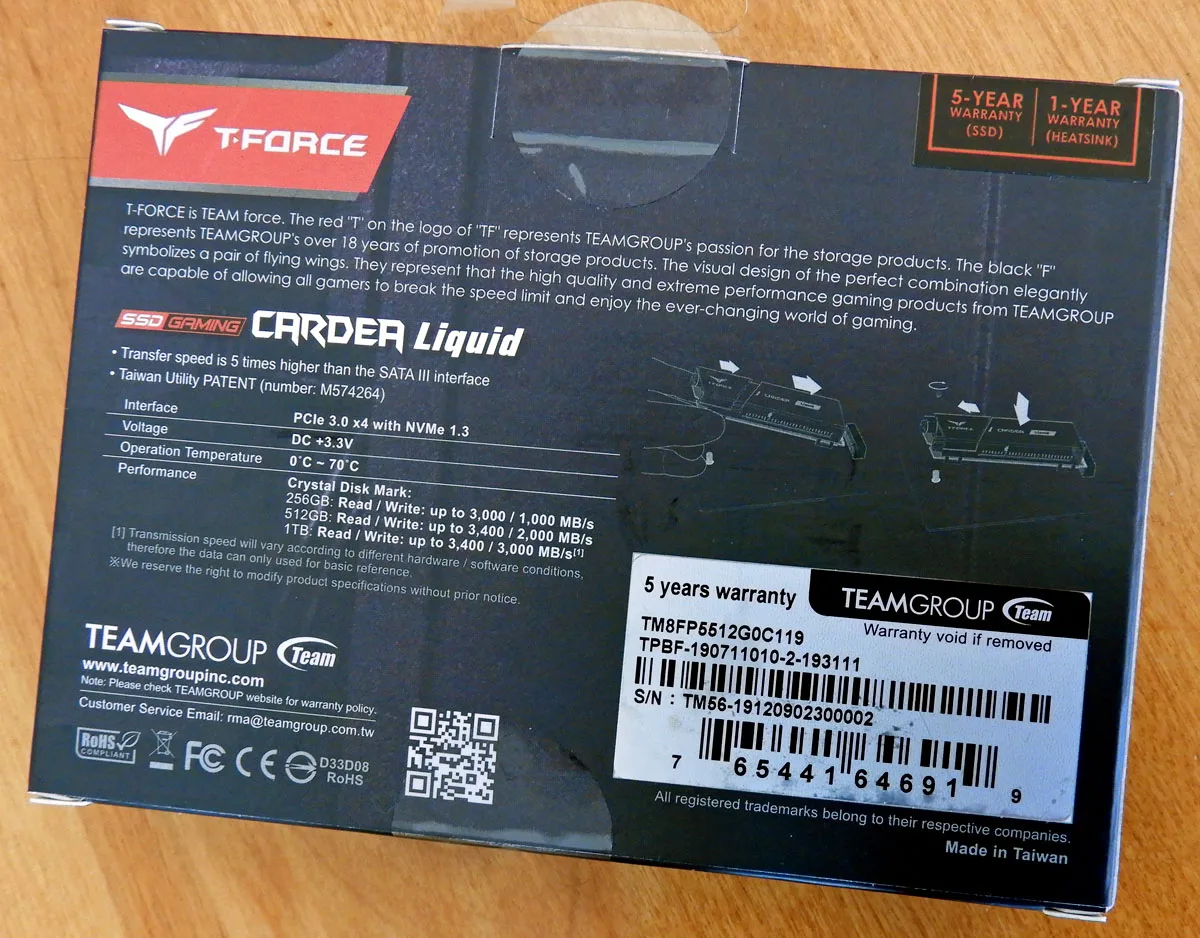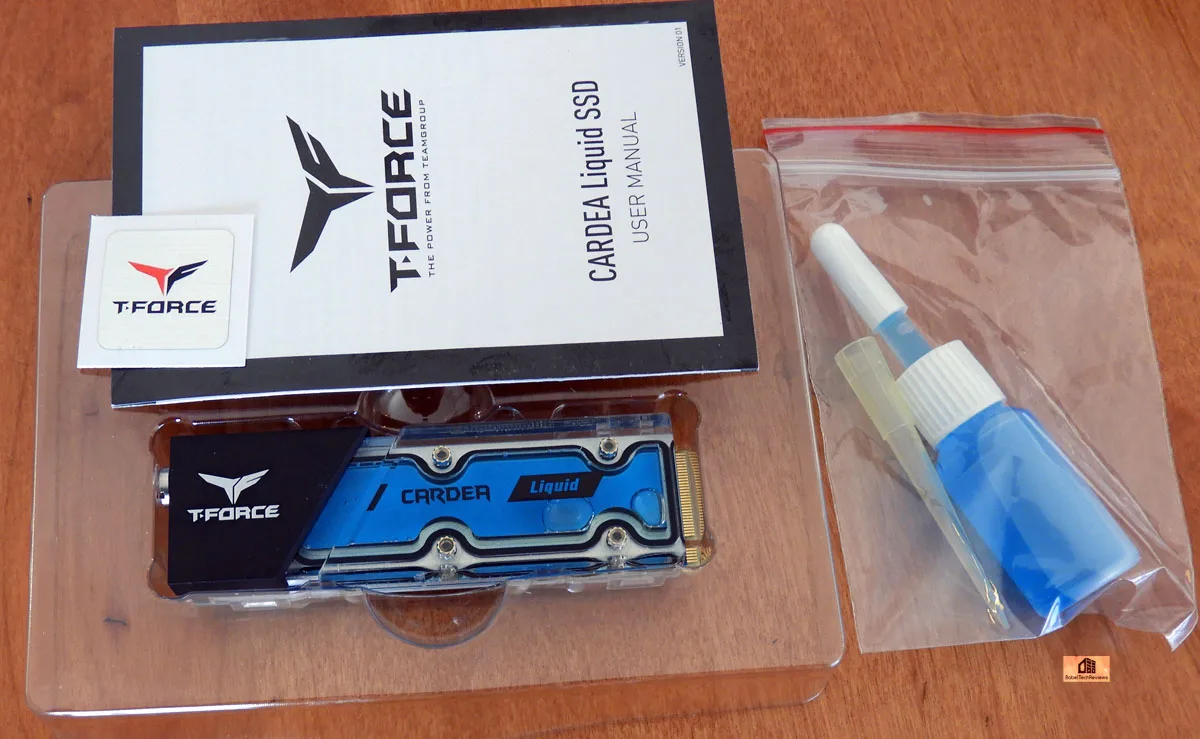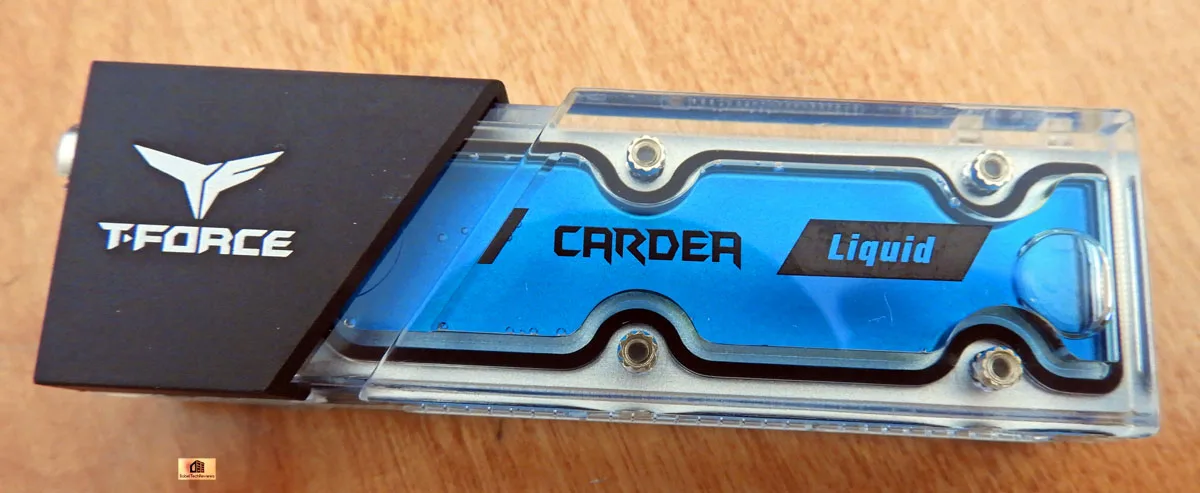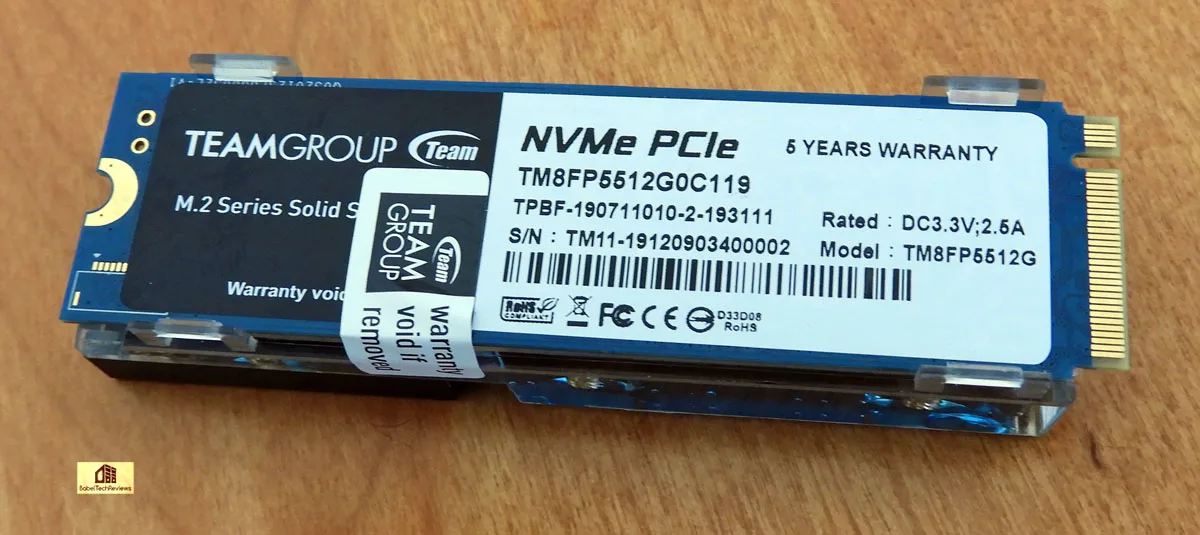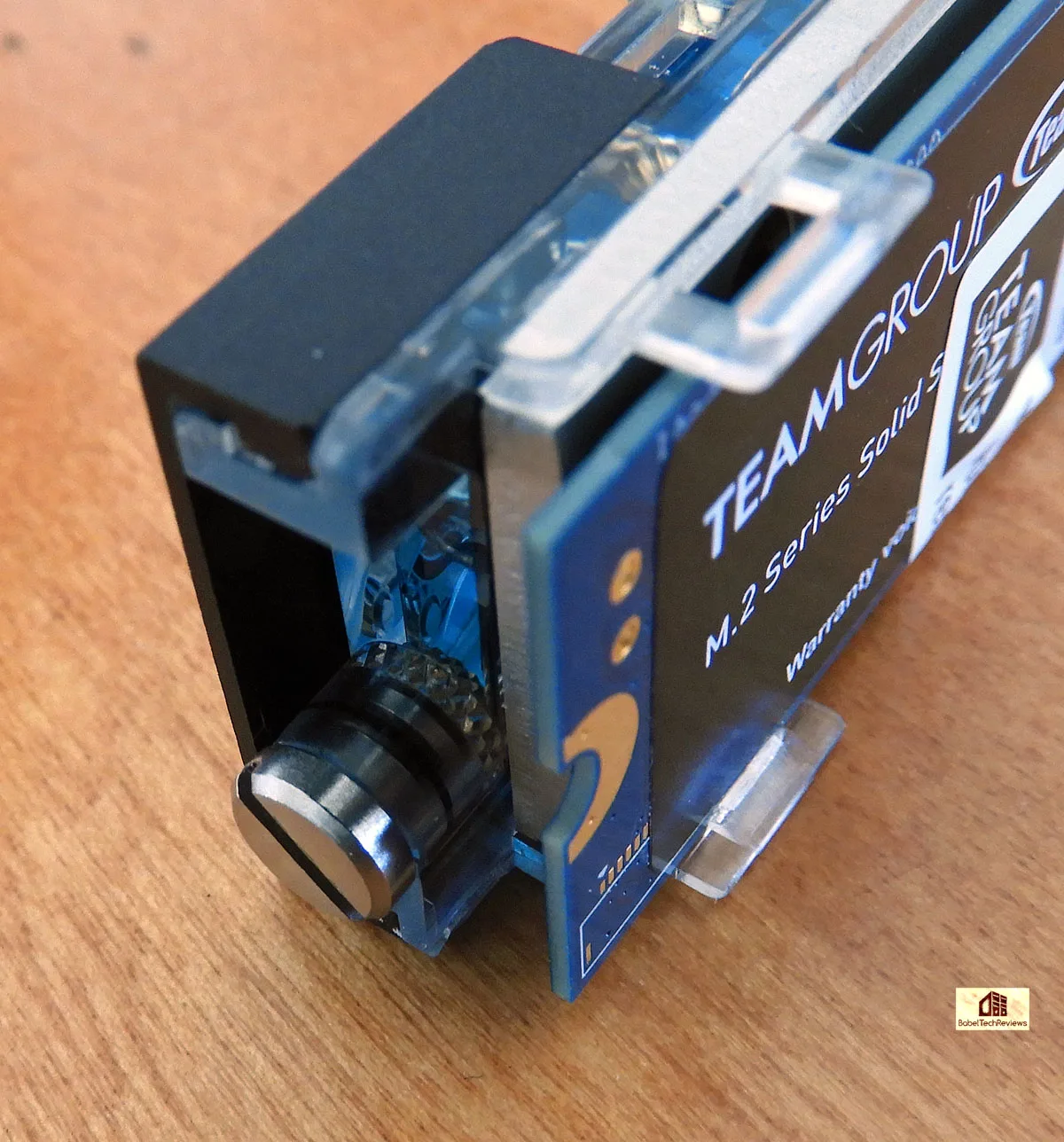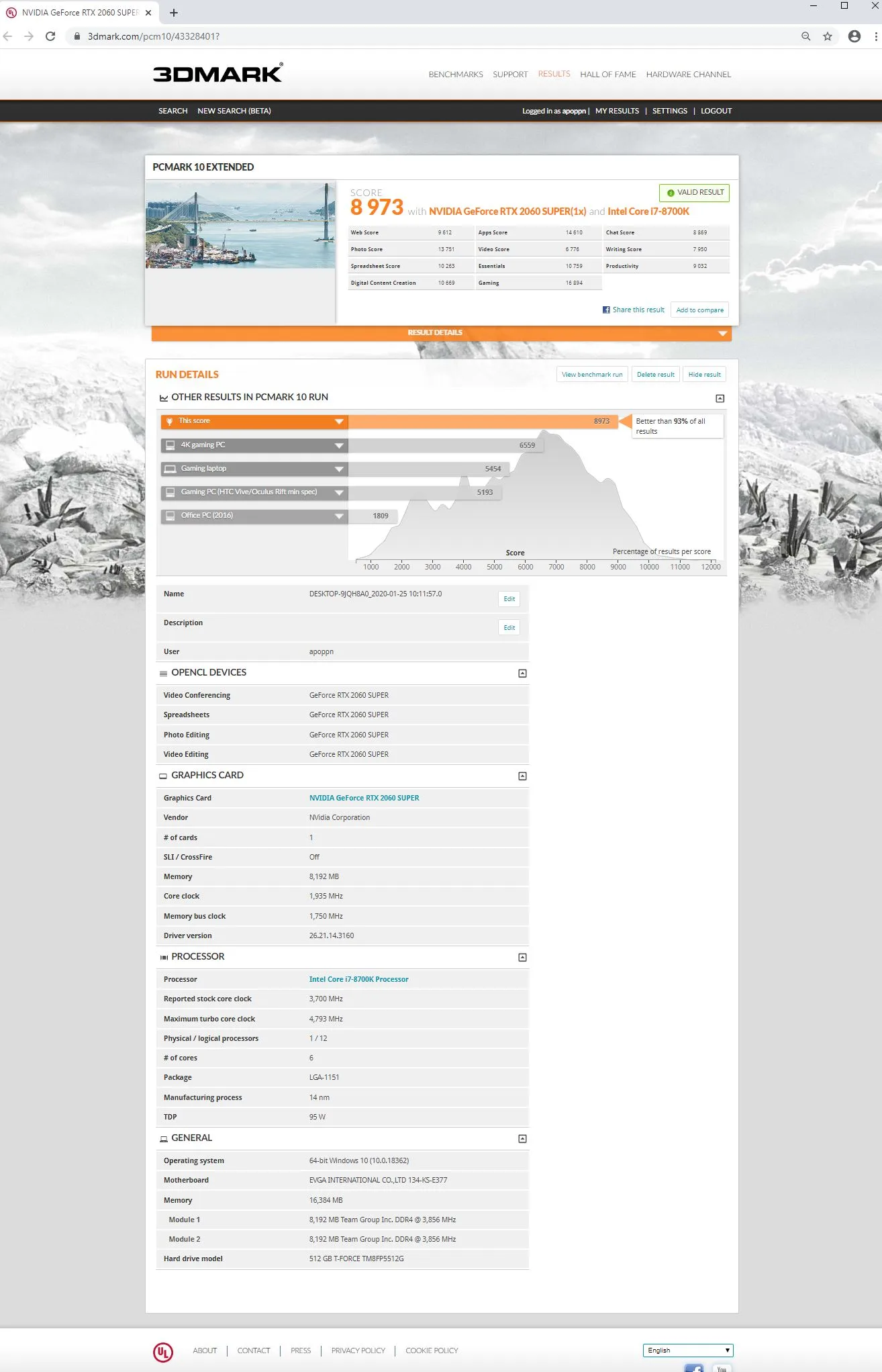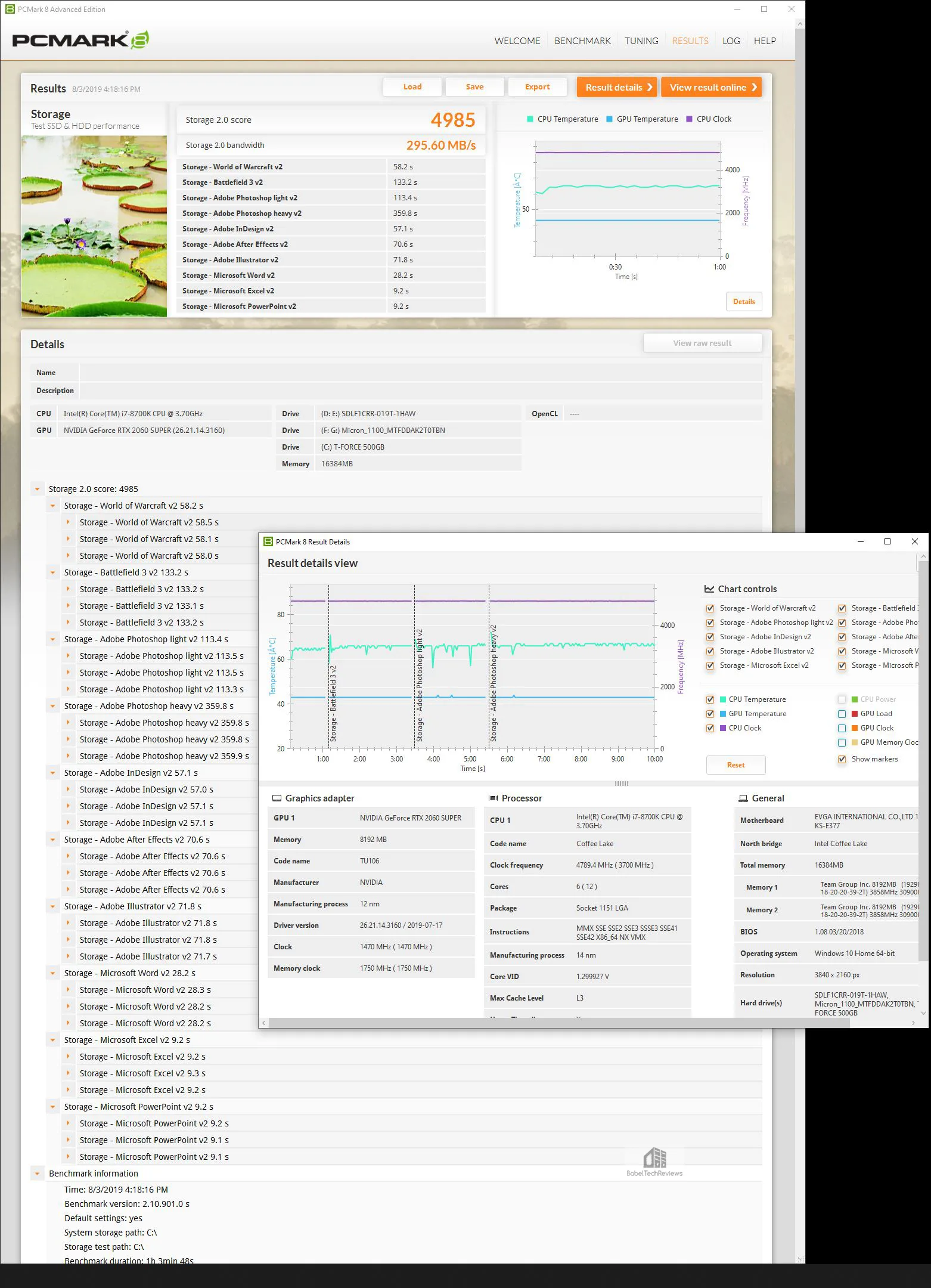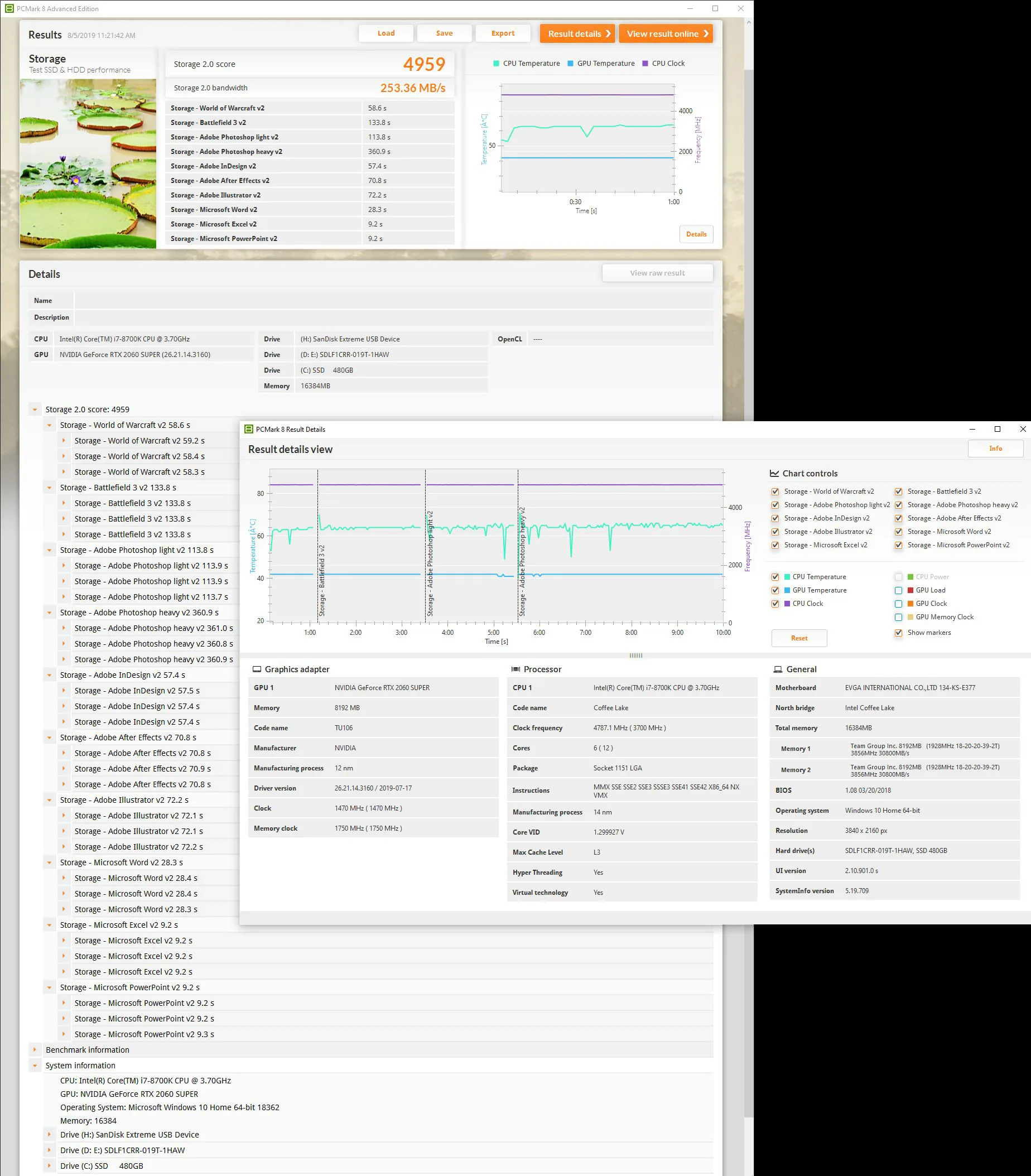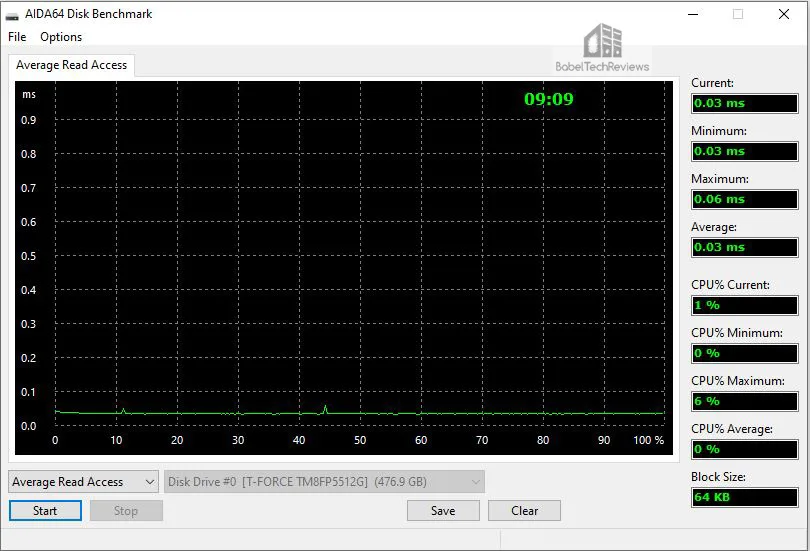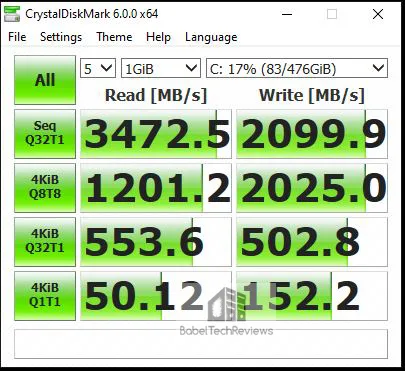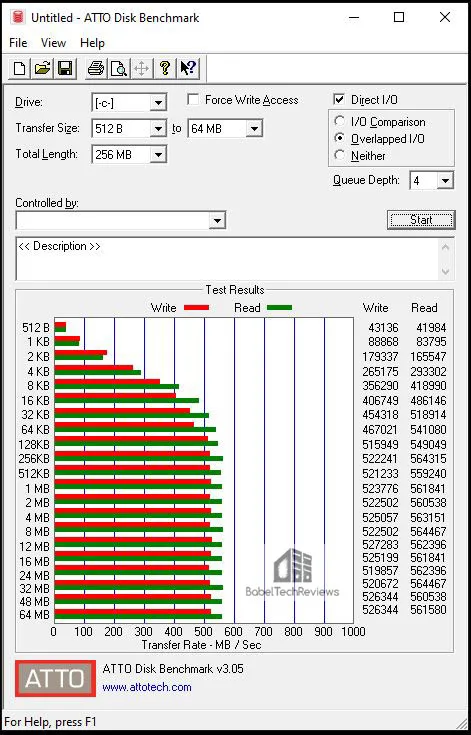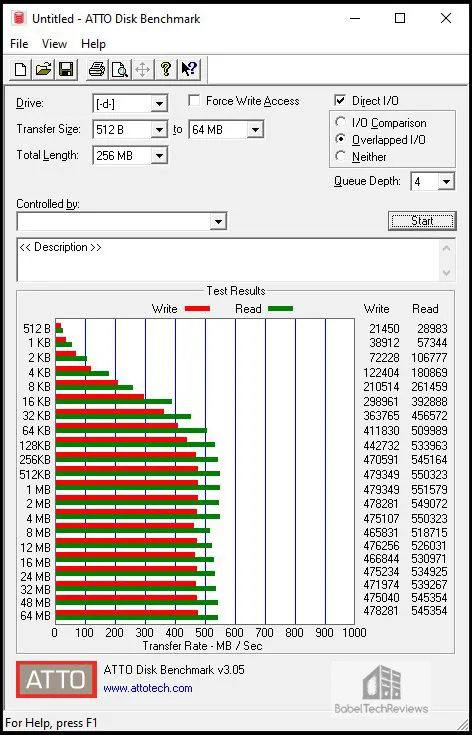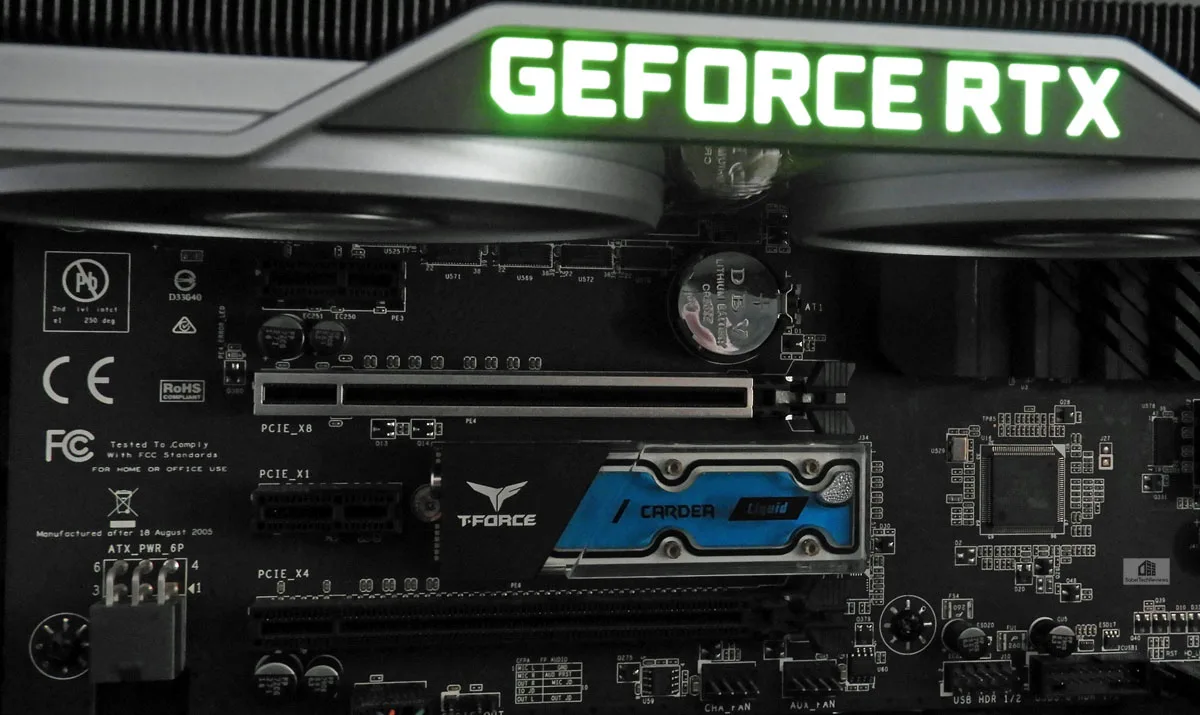The Watercooled 512GB T-FORCE CARDEA Liquid M.2 PCIe SSD Review – Form Over Function?
The T-FORCE CARDEA Liquid stands out from other M.2 form factor SSDs (Solid State Drives) by using a clear cover that holds a colored liquid acting as an attractive and unique type of heatsink. Boasting fast M.2 SSD speeds, the CARDEA Liquid SSD is designed to be the focus of a PC that is meant to be displayed. 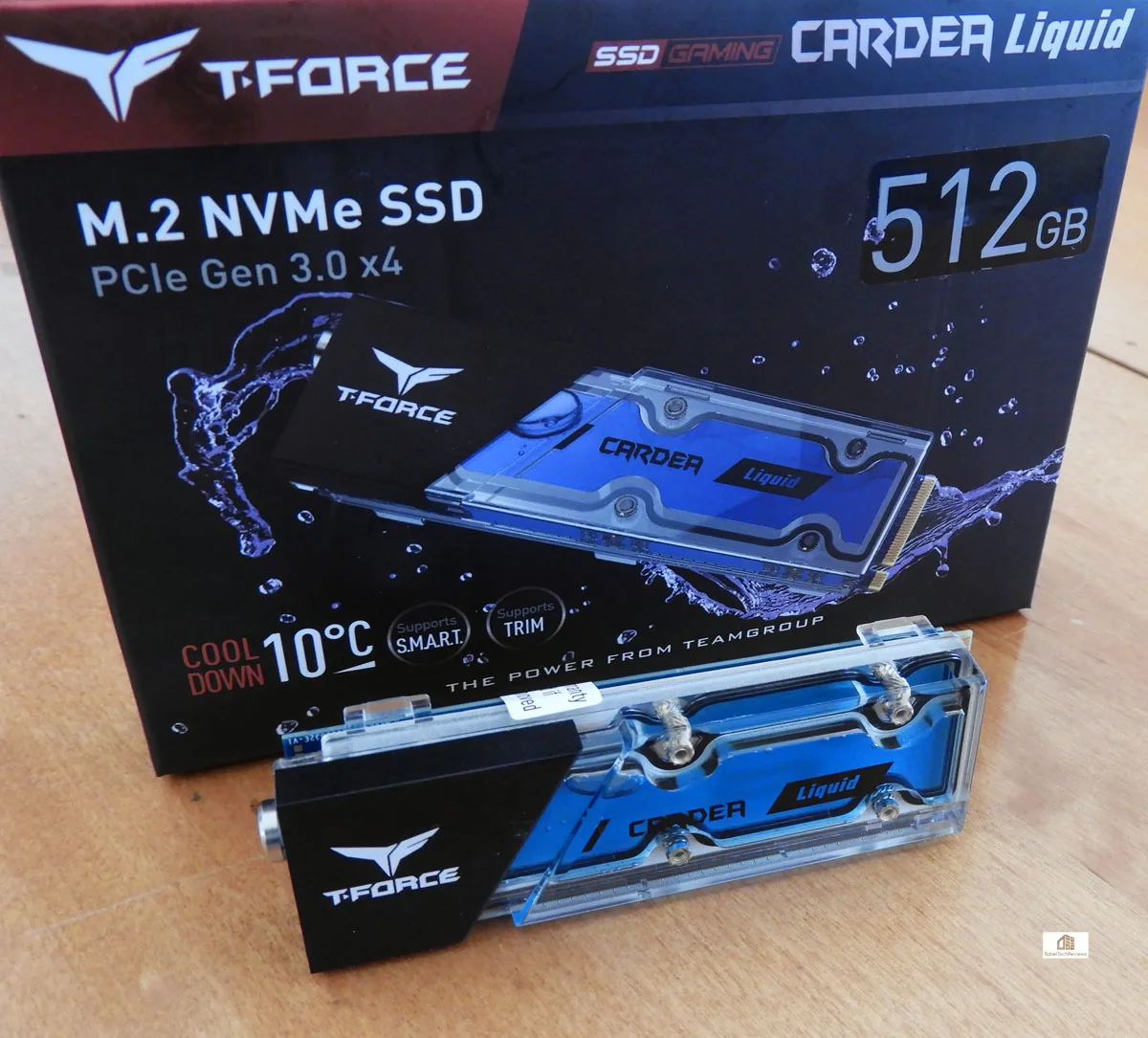
[UPDATED at 6 AM PT on 01/30/20. MSRP of the 512GB version is $100.90 and $169.99 for the 1TB version.] Currently, the 512GB version we are reviewing is unavailable anywhere we looked and our review sample came directly from Team Group. We will focus on the CARDEA Liquid SSD performance to see if it can match its eye-pleasing design by comparing it with six other drives. Three of the drives are 500GB SATA III based SSDs, one is a portable 240GB USB 3.1 SSD, one is a 2TB solid state hard drive, and the fastest in BTR’s library until now is the 480GB Kingston A-1000 NVMe M.2 SSD.

BTR uses two identical 480GB Team Group L5 LTE SATA III SSDs as boot drives – one for AMD and one for NVIDIA – together with a 1.92 TB SanDisk SATA III SSD and a 2 TB Micron 1100 SATA III SSD for our primary game storage. In addition, we also use a T-FORCE Vulcan SATA 500GB SATA III SSD for additional storage whereas previously we used a 2TB Seagate FireCuda Solid State Hard Drive (SSHD) for additional storage.
BTR’s test setup uses Windows 10 64-bit, featuring an Intel Core i7-8700K overclocked to 4.8GHz for all cores as set in the EVGA Z370 FTW motherboard’s BIOS, and 16 GB of T-FORCE XTREEM DDR4 at 3866MHz. The settings and hardware are identical except for the four drives being tested, and the graphics are powered by a RTX 2060 SUPER Founders Edition (FE). BTR’s October review of the PD400 GB SSD and January review of the DELTA MAX SSD were set up using the same drivers and conditions, so we will reuse those results for this evaluation.
We benchmark with all of our drives at less than 90% capacity, and in addition, all of the drives have been in use for months except for the CARDEA Liquid SSD which has been “dirtied” using IOmeter as well as being used for storage, so our testing tends to give more real world performance results.
Here are the features and specifications of the T-FORCE CARDEA LIQUID SSD taken directly from the T-FORCE website.
FEATURES
- World’s first water cooling M.2 solid state drive.
- Superior performance – read speed up to 3400 MB/s[1] which can improve the speed and performance of the overall system.
- Support latest NVMe1.3 protocol.
- Support S.M.A.R.T./TRIM technology – monitoring hard drive status efficiently and bring out its best performance.
- Structure design is a combination of craftsmanship and fashion.
Specifications
Details and specifications can be found on the Team Group website.
The key highlight is that the CARDEA Liquid M.2 PCIe SSD is very good-looking when it is displayed as a focus of a well thought-out PC built for display. Besides good-looking, it is fast, durable, uses little power, and it is backed by Team Group’s 5-year warranty. Please note that the heatsink is only warrantied for 1 year.
Next we unbox the T-FORCE CARDEA Liquid SSD.
Unboxing
The T-FORCE CARDEA Liquid 512GB M.2 NVMe SSD comes in a small box that claims a “10C cool down” as well as supporting S.M.A.R.T. and TRIM.
The other side of the box gives some specifications that show it is certainly fast but not blazing fast for a NVMe M.2 PCIe SSD. It quotes Crystal Disk Mark that we also confirmed as having Read speeds up to 3,400MB/s and 2000MB/s Write speeds. We note a 5-year warranty on the SSD but only 1 year on the heatsink.
The SSD arrives well packaged with a user manual, a badge, and a liquid coolant refill kit.
Here is a closer look at the T-FORCE CARDEA Liquid SSD which looks great with an all-blue inner surface due to the colored cooling liquid contrasted with the stylized T-FORCE logo in white on a sliding black metal cap.
The CARDEA Liquid’s obverse features the PCB covered by the 5-year warranty sticker. The “Warranty Void if Removed” sticker tends to tear quite easily when installing the SSD into the M.2 slot.
You can gauge the amount of water in the reservoir by looking at the edge.
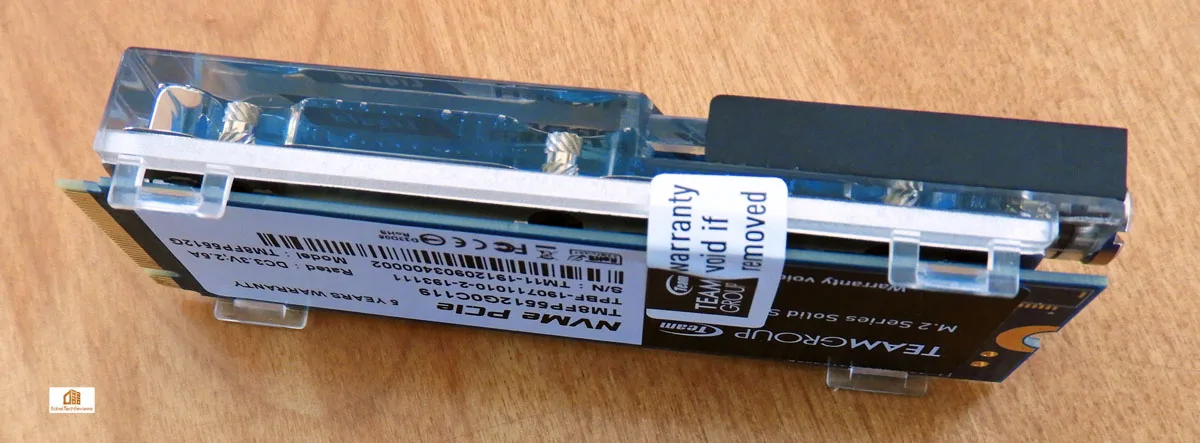 The cap slides to expose the screw covering the inlet. Eventually, a user will have to add liquid and Team Group recommends against using tap or distilled water. They also say that mineral oils should not be used. They offer a kit to change the color of your CARDEA Liquid SSD by simply changing to a different colored fluid. We will cover this kit in a short follow-up review after we receive it from Team Group.
The cap slides to expose the screw covering the inlet. Eventually, a user will have to add liquid and Team Group recommends against using tap or distilled water. They also say that mineral oils should not be used. They offer a kit to change the color of your CARDEA Liquid SSD by simply changing to a different colored fluid. We will cover this kit in a short follow-up review after we receive it from Team Group.
After installing the SSD, the user may need to format it before using it. If you are planning to clone it, make sure both disks are GUID or convert one of them first.
Lets look at our test configuration next.
Test Configuration – Hardware
- Intel Core i7-8700K (HyperThreading and Turbo boost is locked on to 4.8 GHz for all six cores. Coffee Lake DX11 CPU graphics.
- EVGA Z370 FTW motherboard (Intel Z370 chipset, latest BIOS, PCIe 3.0/3.1 specification, CrossFire/SLI 8x+8x), supplied by EVGA
- T-FORCE XTREEM 16GB DDR4 (2x8GB, dual channel at 3866MHz), supplied by Team Group
- RTX 2060 SUPER Founders Edition 8GB, stock clocks, on loan from NVIDIA
- T-FORCE CARDEA Liquid 512GB SSD Supplied by Team Group
- T-FORCE DELTA MAX 500GB SSD Supplied by Team Group
- Team Group PD400 External/Portable 240GB SSD, Supplied by Team Group
- T-FORCE Vulcan 500GB SSD Supplied by Team Group
- Kingston A1000 480 GB NVMe PCIe SSD, supplied by Kingston
- Team Group L5 LITE 3D 2.5″ 480 GB SSD
- 2TB Seagate 7200 rpm SSHD (Solid State Hard Drive)
- Edifier R1280T active desktop speakers
- Monoprice Crystal Pro 4K
- ETEKCITY LaserGrip 774 infrared thermometer
Test Configuration – Software
- Nvidia’s GeForce 431.60 WHQL drivers were used. High Quality, prefer maximum performance, single display.
- VSync is off in the control panel.
- AA enabled as noted in games; all in-game settings are specified with 16xAF always applied.
- All results show loading time in seconds.
- Highest quality sound (stereo) used in all games.
- Windows 10 64-bit Home edition.
- Latest DirectX
- All games are patched to their latest versions at time of publication.
- MSI’s Afterburner, latest version.
- IOmeter
- HD Tach
- HD Tune
- AS SSD
- ATTO
- Crystal DiskMark
- Windows Explorer File copying
PC Game & Level Loading Suite
- World of Warcraft (PCMark 8)
- Battlefield 3 (PCMark 8)
Synthetic Benching Suites
- SiSoft Sandra 2020
- AIDA64
- PCMark 8
Nvidia Control Panel settings:
We used MSI’s Afterburner to set the power and temp limits to their maximums.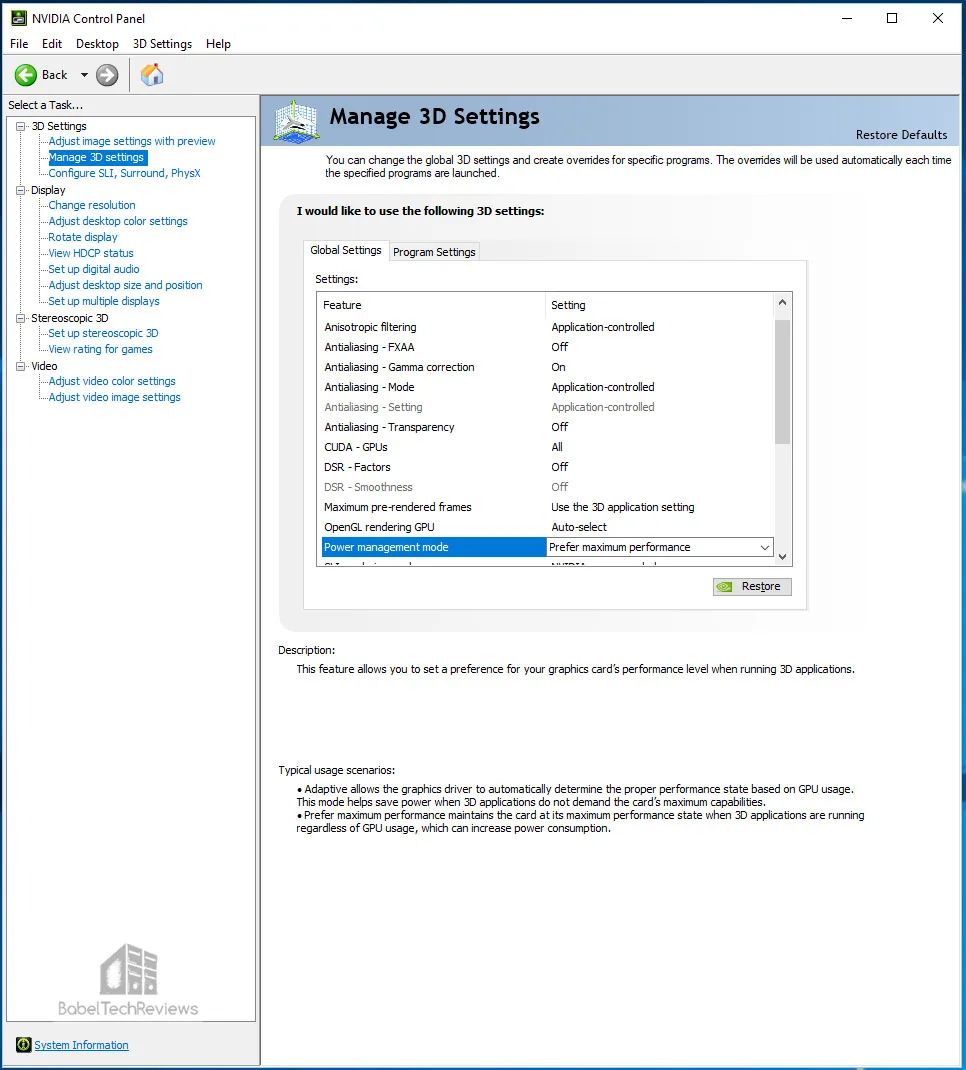
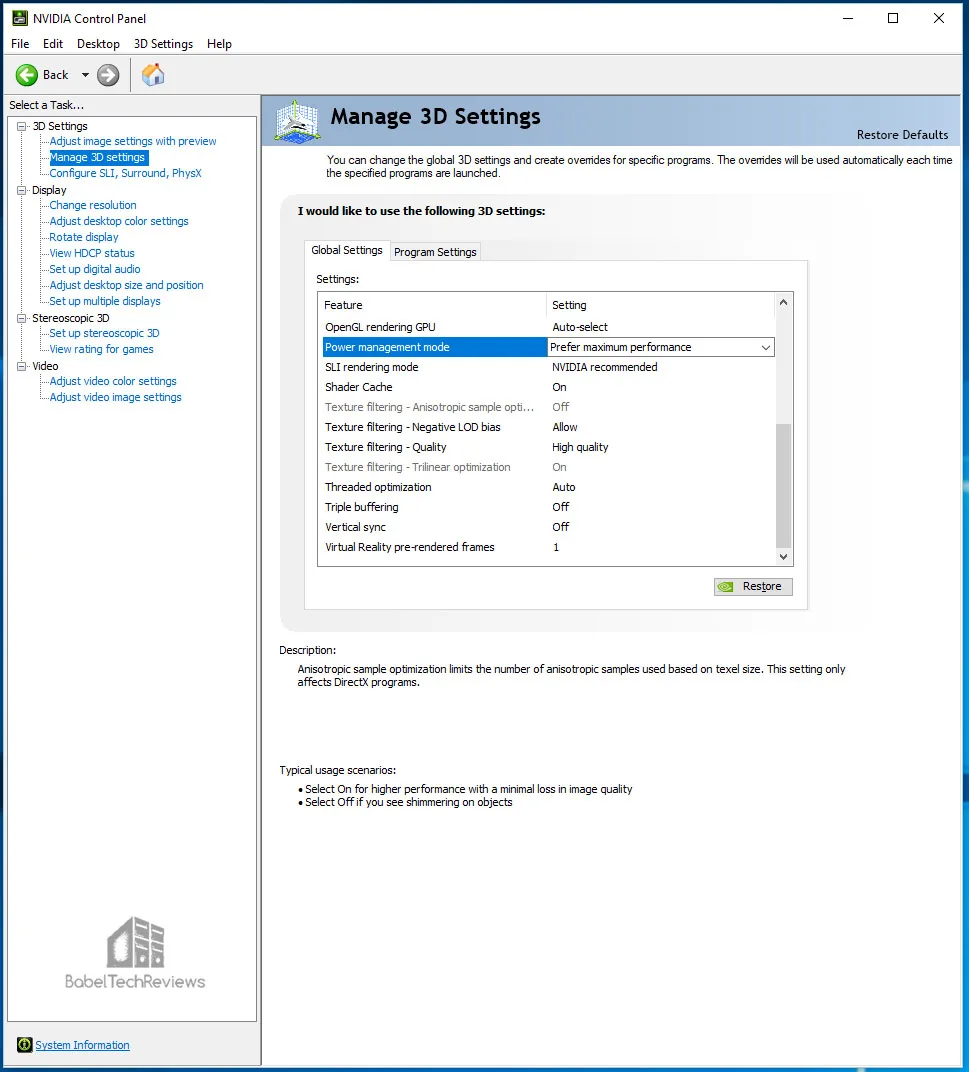
Let’s head to our benching results.
Benchmarking the T-FORCE CARDEA Liquid M.2 PCIe SSD
Benchmarking SSDs is not an exact science as there is usually some variability between runs. However, by using multiple real world and synthetic tests, it may be possible to get a good idea of the CARDEA Liquid M.2 PCIe SSD’s relative performance across all seven of our tested drives.
First, we will will look at synthetic benchmark suites to highlight the differences between our drives and we shall start with PCMark 10.
PCMark 10
UL (formerly Futuremark) is well-respected as a developer and publisher of PC benchmark applications for nearly two decades. Although PCMark benches are synthetic tests, they provide a good measure of system performance. PCMark 10 is UL’s seventh major update to the PCMark series. PCMark 10 was primarily developed for Windows 10 and it builds upon the PCMark 8 platform for a complete package of vendor-neutral and easy-to-use benchmarks for home or office environments.
Unfortunately, in comparison to PCMark 8, PCMark 10 is missing key elements including detailed storage testing, and it is not possible to test attached drives as with the earlier suite. We use PCMark 10’s Extended settings.
To properly compare the PCMark 10 scores, look at the detailed results of each SSD you want to compare remembering that the Kingston A-1000 is the only other M2 SSD and the T-FORCE Vulcan would be the overall fastest SATA-based SSD. The results are presented in approximate order of the fastest to the slowest drive ending with the portable USB SSD and the solid state hard drive (SSHD).
First we look at the CARDEA Liquid 500 GB SSD system that scores 8973 taking the top position by a large margin.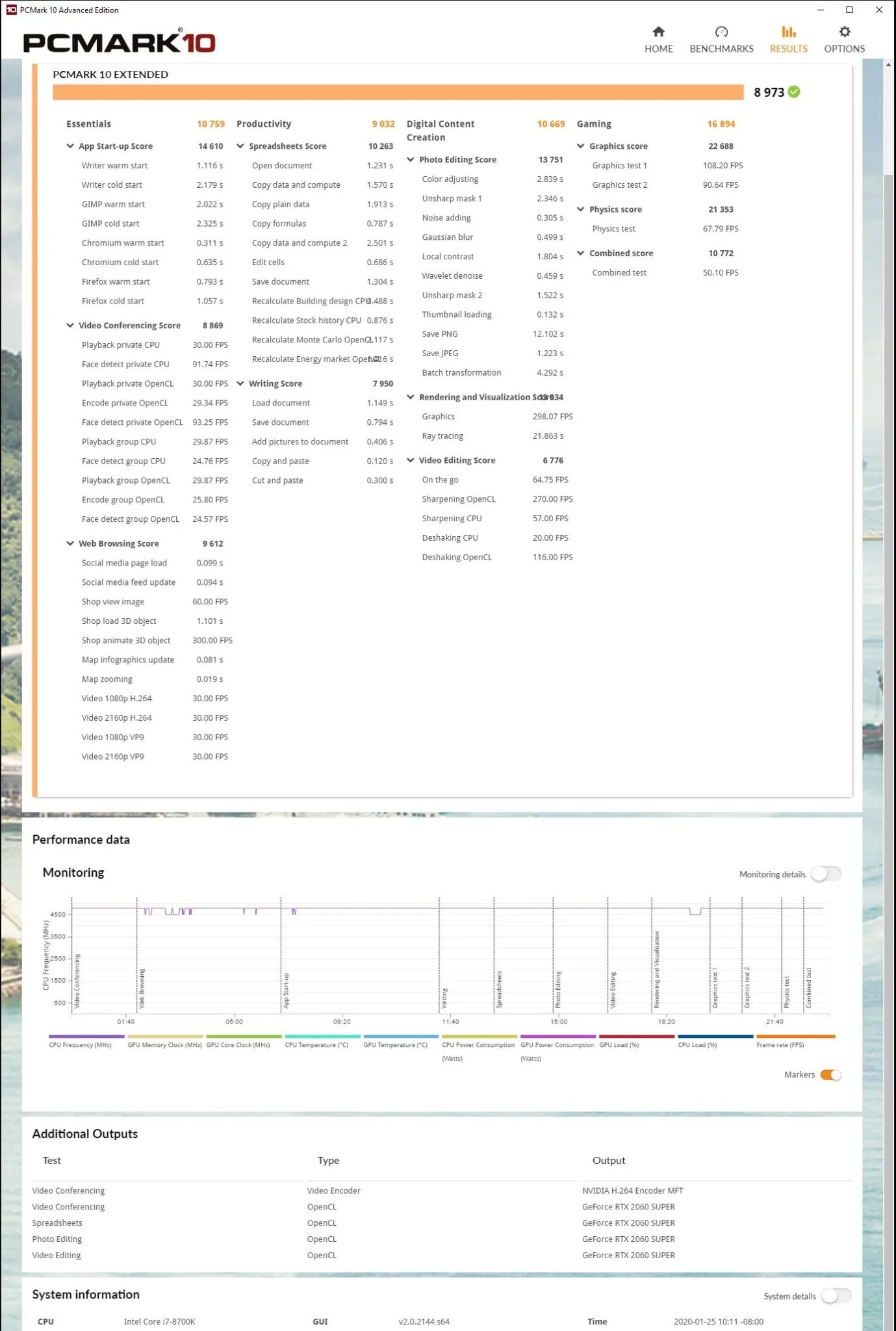
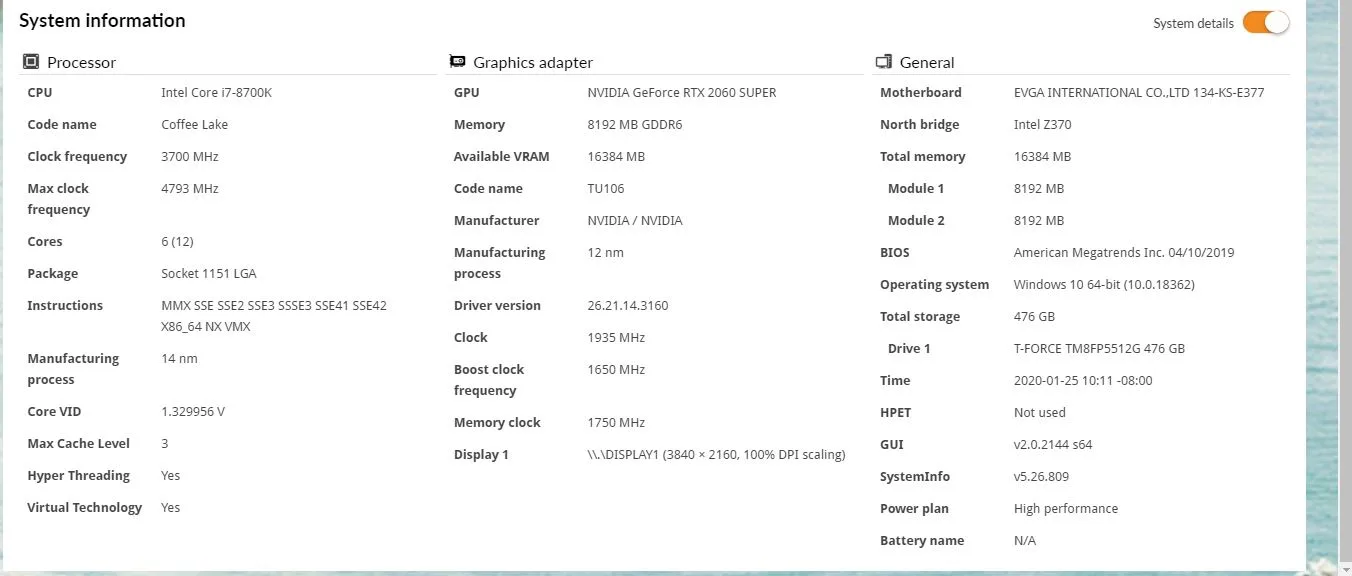
The same PC with the Kingston A1000 480 GB SSD scores 8863 which is ahead of the 480GB Team Group PC score, but it is a bit behind the T-FORCE Vulcan 500GB SSD results.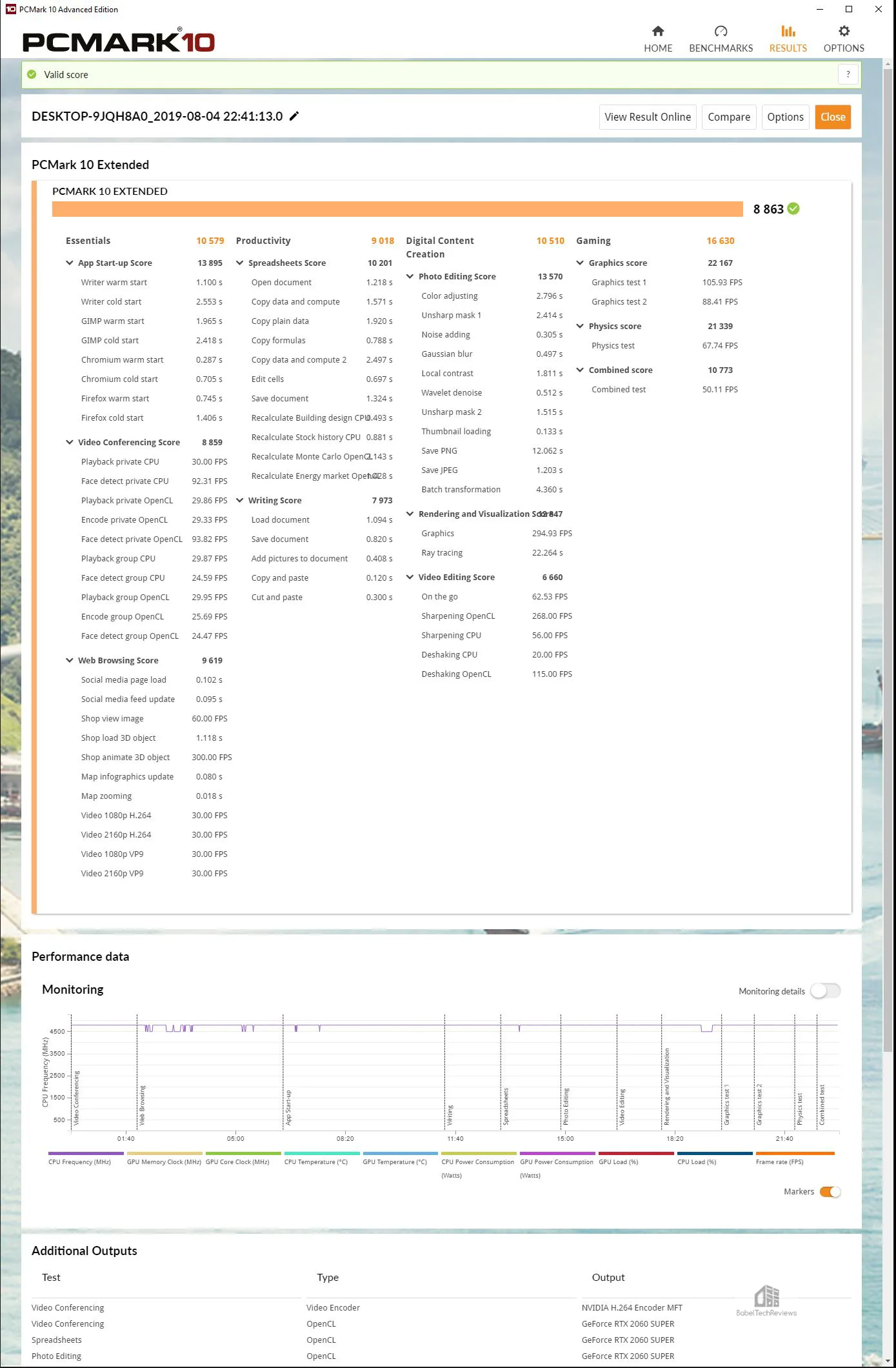
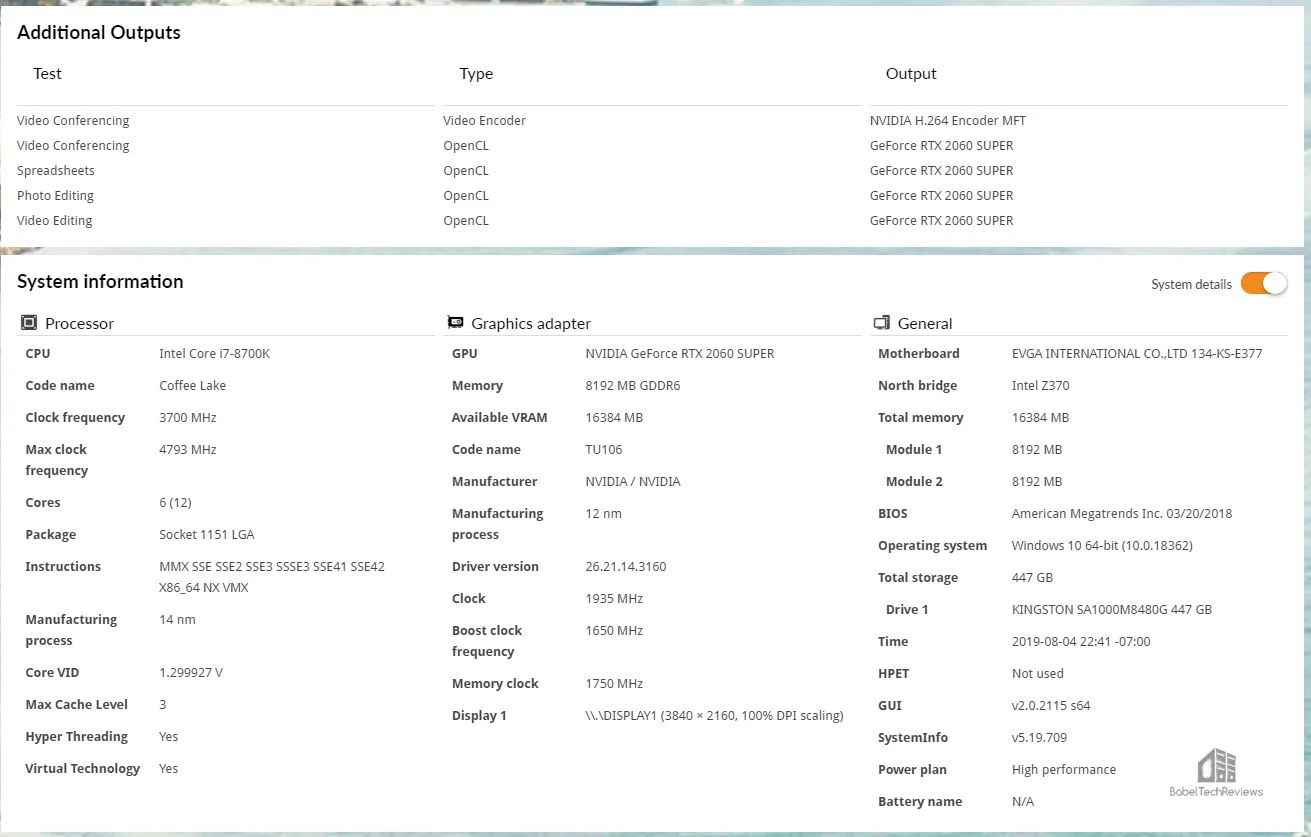 The system with the T-FORCE Vulcan 500GB SSD scores 8880.
The system with the T-FORCE Vulcan 500GB SSD scores 8880.
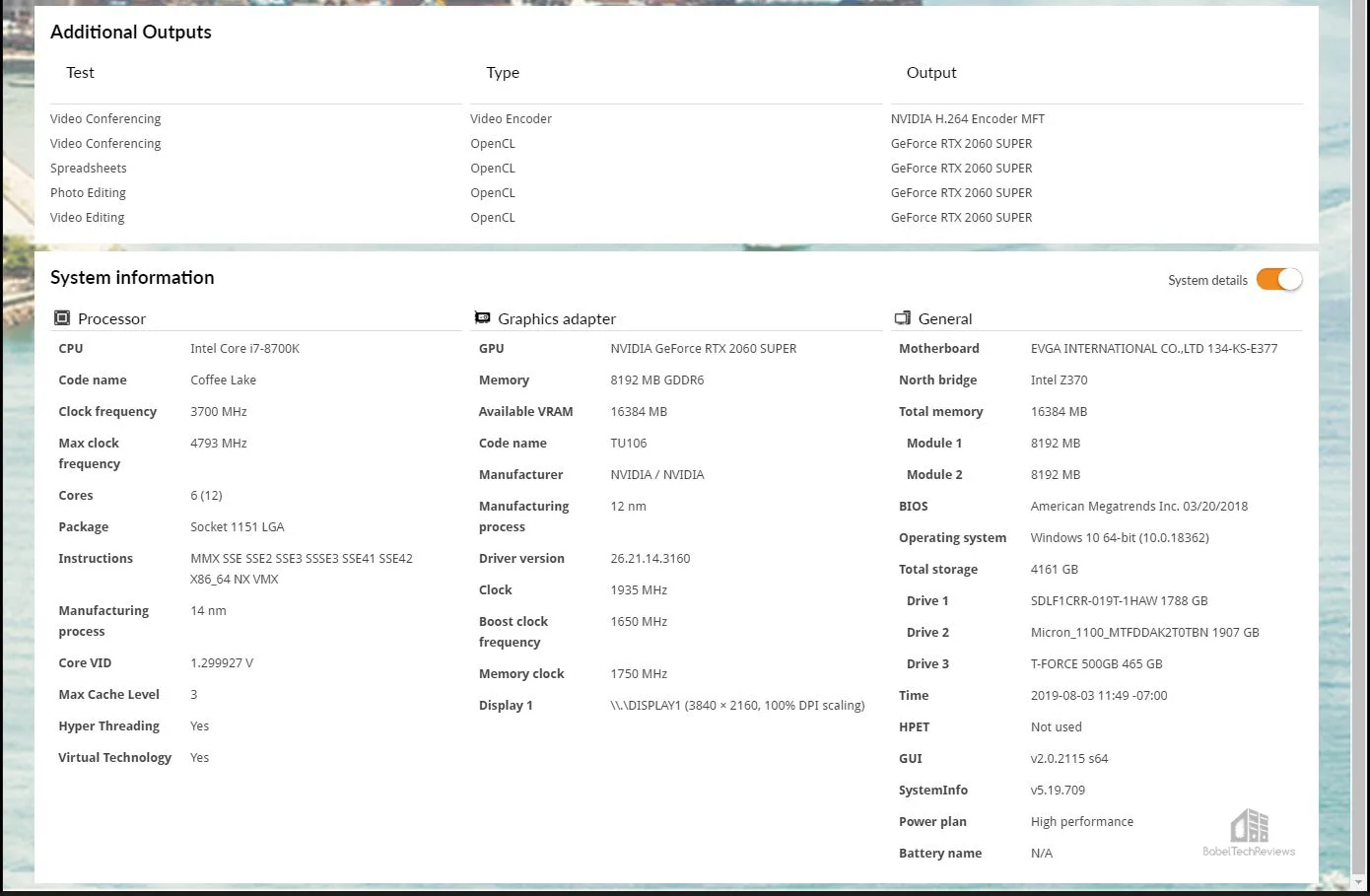
The system with the T-FORCE Delta Max 500GB SSD scores 8849
The same system with the Team Group 480 GB SSD scores 8831.
 The FireCuda 2TB SSHD scores 7883.
The FireCuda 2TB SSHD scores 7883.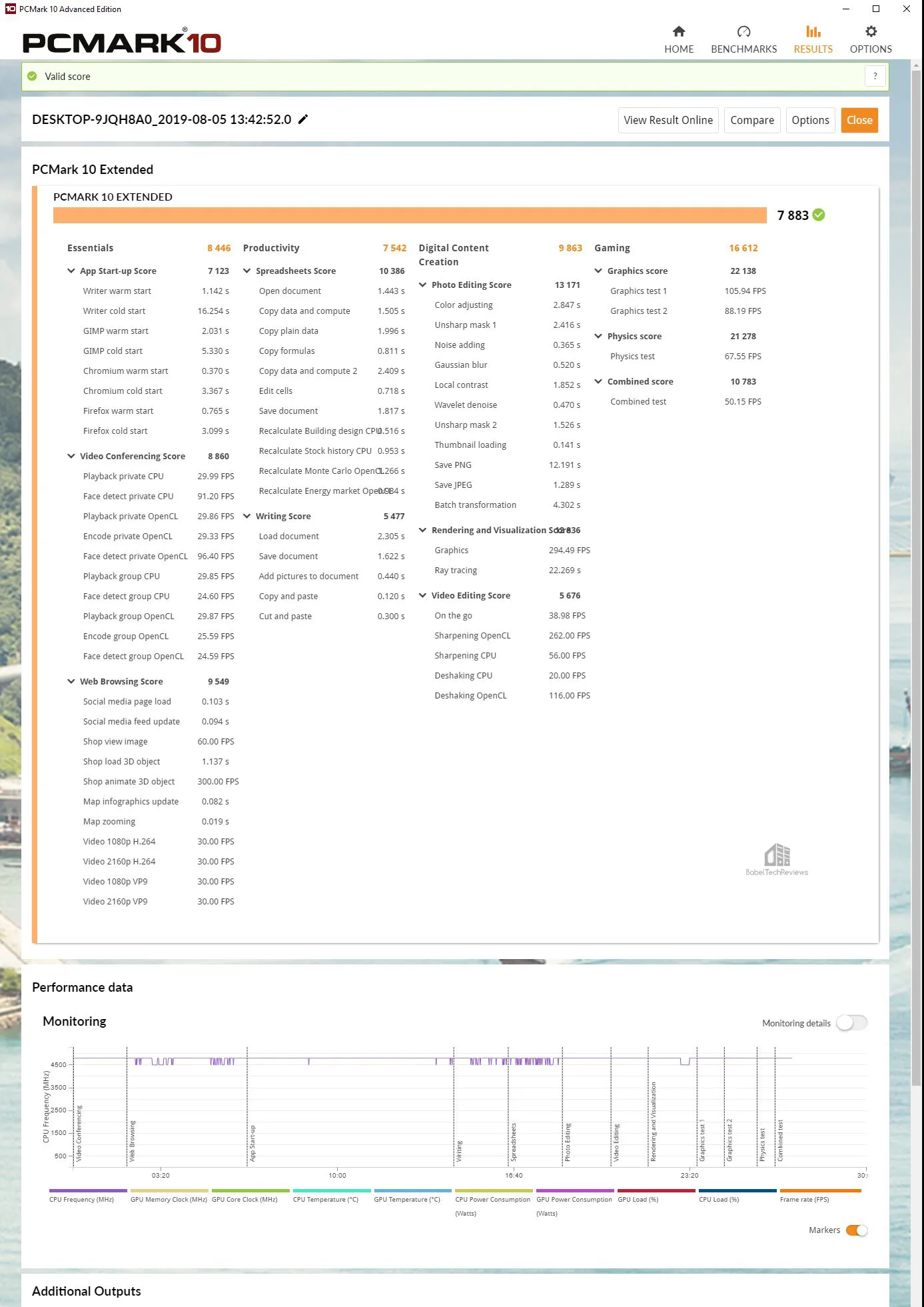
 Here is the summary of the six drives that were tested using PCMark 10.
Here is the summary of the six drives that were tested using PCMark 10.
The T-FORCE CARDEA Liquid gets the highest score by a margin of 93 points followed by T-FORCE Vulcan 500GB SSD PC followed by the Kingston A-1000 and then the DELTA MAX with the Team Group L5 LTE SSD as the slowest tested SSD. There isn’t a lot of difference in overall performance between the five slower SSDs nor is it easy to see exactly where one scores higher by looking at the individual tests. Fortunately, PCMark 8 is a better storage test and it is up next.
PCMARK 8
PCMark 8 has an excellent storage test which actually uses real world timed benchmarks that include loading World of Warcraft and Battlefield 3 as well as timing how long it takes to load popular Adobe and Microsoft apps.
The T-FORCE CARDEA Liquid 500GB SSD scores 5076 with a total Storage 2.0 Bandwidth of 599.03 MB/s. And for gamers, it took 57.4 seconds to load World of Warcraft and 131.5 seconds for Battlefield 3 to load.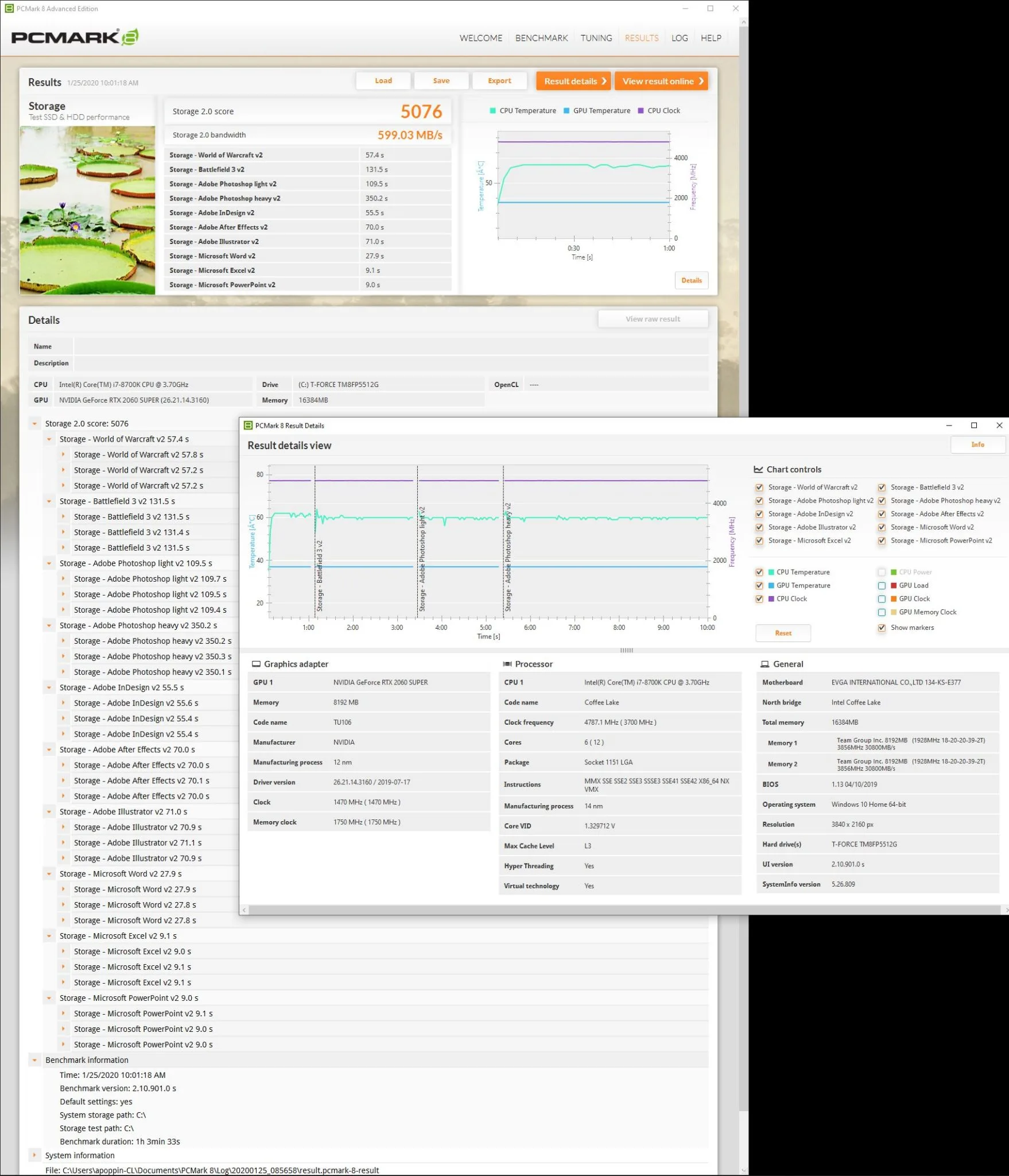
Here are the online CARDEA Liquid results.
The Kingston A1000 480 GB SSD scores 5032 with a total Storage 2.0 Bandwidth of 401.30 MB/s. Of primary interest to gamers, it took 58.0 seconds to load World of Warcraft and 132.6 seconds for Battlefield 3 to load.
The T-FORCE Delta Max 500GB SSD scores 4962 with a total Storage 2.0 Bandwidth of 252.94 MB/s. And for gamers, it took 58.4 seconds to load World of Warcraft and 133.7 seconds for Battlefield 3 to load.
The Team Group L5 480 GB SSD scores 4959 with a total Storage 2.0 Bandwidth of 253.36 MB/s. Most importantly for a gamer, it took 58.6 seconds to load World of Warcraft and 133.8 seconds for Battlefield 3 to load.
Here is the PCMark 8 comparative loading times chart for World of Warcraft and for Battlefield 3. All of these charts are also included in the Summary.
Here are the comparative overall PCMark 8 scores including storage bandwidth results.
The Kingston PCIe A1000 M.2 480GB SSD is the fastest drive overall, however, there isn’t a lot of practical difference between its results and any SATA – or even external USB 3.1 Gen 1 SSD game loading speeds. In contrast to using any SSD, the SSHD takes nearly twice as long to load the tested two games. A SSHD only takes advantage of repeated loading of levels or games, and after 2 or 3 loads, then it will set up more quickly, approaching SSD speeds.
SiSoft Sandra 20/20
Before we get to gaming, we want to see exactly where drive performance results differ, and there is no better tool than SiSoft’s Sandra 2020. SiSoftware Sandra (the System ANalyser, Diagnostic and Reporting Assistant) is an complete information & diagnostic utility in one complete package. It is able to provide all the information about your hardware, software and other devices for diagnosis and for benchmarking. In addition, Sandra is derived from a Greek name that implies “defender” or “helper” – PC’s Wonder Woman of benchmarking.
There are several versions of Sandra 2020, including a free version of Sandra Lite that anyone can download and use. It is highly recommended! SiSoft’s Sandra 2020 SP1 is the very latest version (although we are still using the August version), and we are using the full engineer suite courtesy of SiSoft. It will benchmark and analyze all of the important PC subsystems and even rank your PC as well as make recommendations for improvements.
Here are the Sandra disk benchmarking tests in a single chart summarizing the performance results of our four drives
 Trailing after the Cardea Liquid M.2 PCIe SSD, the Kingston A1000 480 GB NVMe SSD’a overall performance is faster than the other three SATA III SSDs although the DELTA MAX SSD comes in ahead of the Team Group L5 LTE SSD but just behind the Vulkan SSD. The SSHD sits way behind SSDs in every metric tested.
Trailing after the Cardea Liquid M.2 PCIe SSD, the Kingston A1000 480 GB NVMe SSD’a overall performance is faster than the other three SATA III SSDs although the DELTA MAX SSD comes in ahead of the Team Group L5 LTE SSD but just behind the Vulkan SSD. The SSHD sits way behind SSDs in every metric tested.
AIDA64 v6.0
AIDA64 is the successor to Everest and it is an important industry tool for benchmarkers. AIDA64’s benchmark code methods are written in Assembly language, and they are extremely optimized for every popular AMD, Intel and VIA processor core variants by utilizing the appropriate instruction set extensions. We use the Engineer’s version of AIDA64 courtesy of FinalWire. AIDA64 is free to to try and use for 30 days.
We run the AIDA64 Disk Benchmark and the 4 individual READ tests for each drive, and we include the image for each test and then summarize them in a chart. These tests are incredibly detailed and there are a lot of customization options available so we run the default tests. We did not run the Read tests as they destroy all of the data on the disks being tested.
- The Linear Read test measure the sequential performance by reading or writing all sectors without skipping any. It’s a linear view of the drives overall performance from its beginning to end.
- The Random Read test measures the random performance by reading variable-sized data blocks at random locations on the surface of the drive and they are combination of both speed and access times as its position changes before each new operation.
- The Access time tests are designed to measure the data access performance by reading 0.5 KB data blocks at random drive locations.
- The Buffered Read test will measure the drive caching.
The overall disk benchmark is relatively quick, but the individual benchmarks take much longer to chart the drive’s performance.
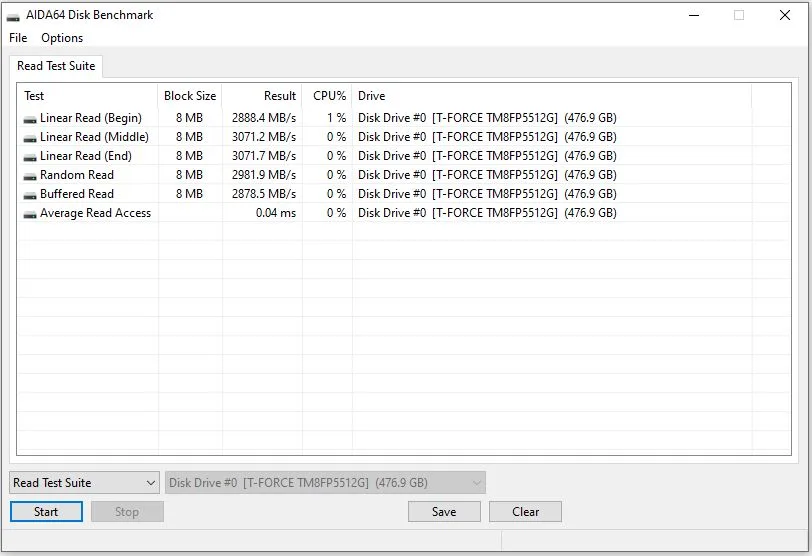 Above are the T-FORCE Delta Max SSD’s overall quick disk benchmark results followed by four images of detailed individualized Read tests.
Above are the T-FORCE Delta Max SSD’s overall quick disk benchmark results followed by four images of detailed individualized Read tests.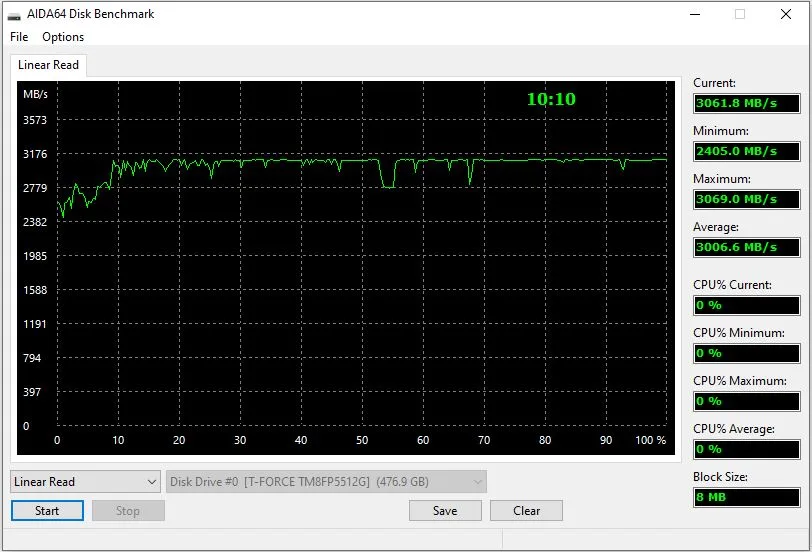

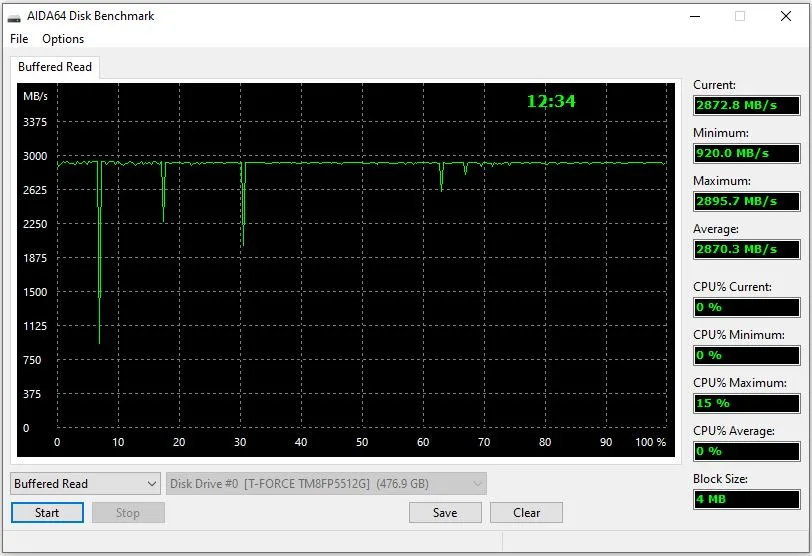
Here is the summary chart comparing our six tested drives:
The CARDEA Liquid performs very well. It has plenty of SSD ‘go’ to go with its show as it is the fastest drive by a large margin. Again the Kingston A1000 480GB M.2 NVMe SSD is ahead of the other SATA-based SSDs where the DELTA MAX sits in the middle. The SATA SSDs are in turn faster than the USB 3.0 external PD400 which in turn is much faster than the SSHD.
CrystalDiskMark 6.0.0
CrystalDiskMark is a HDD benchmark utility for your hard drive that enables you to measure sequential and random read/write speeds. Here are some key features of “CrystalDiskMark”:
- Measure sequential reads/writes speed
- Measure random 512KB, 4KB, 4KB (Queue Depth=32) reads/writes speed
Here are the T-FORCE CARDEA Liquid M.2 PCIe SSD‘s results which confirm Team Group’s Crystal Disk Mark claims of up to 3400MB/s Read and up to 2000MB/s Write speeds:
From the summary chart below, the PCIe M.2 Kingston A1000 SSD scores highest followed by the three SATA SSDs with very similar performance results, then the Team Group USB 3.1 PD400, and in distant last place, the FireCuda 2TB SSHD. 
Let’s look at our next synthetic test, HD Tune. This free standalone synthetic test we use is old and it doesn’t represent real world performance but it does test some important drive metrics and it is still used today. There is also a pay-for HD Tune Pro which is up-to-date and offers more functionality.
HD Tune
HD Tune is a hard disk utility which has the following functions and it measures the performance of:
- Transfer Rate
- Access Time
- CPU Usage
- Burst Rate
- Random Access test
- Write benchmark
Hard Disk information includes partition information, supported features, firmware version, serial number, disk capacity, buffer size, transfer mode.
- Hard Disk Health
- S.M.A.R.T. Information (Self-Monitoring Analysis and Reporting Technology)
- Power On Time
- Error scan
- Temperature display
Here is the T-FORCE CARDEA Liquid 500GB SSD HD Tune benchmark.
Here are the HD Tune benches summarized in a chart of our seven tested drives
As a distant second to the CARDEA Liquid SSD, the Kingston A1000 PCIe M.2 NVMe SSD again leads our tested drives followed by the SATA SSDs, the PD400, and the SSHD trailing in distant last place.
Next we benchmark using AS SSD.
AS SSD
AS SSD is especially designed for Solid State Drives (SSD). This tool contains synthetic and practice tests. The synthetic tests determine the sequential and random read and write performance of the SSD without use of the operating system caches. In Seq-test the program measures how long it takes to read and write a 1 GB file.
In the 4K test, read and write performance for random 4K blocks are determined. The 4K-64-thrd test are similar to the 4K procedure except that the read and write operations on 64 threads are distributed as in the usual start of a program. In the copying test, two large ISO file folders are created, programs with many small files, and a games folder with small and large files. These three folders are copied by the OS copy command with the cache turned on. AS SSD gives an overall “score” after it runs the benchmarks.
Here is the T-FORCE CARDEA Liquid 500GB SSD AS SSD benchmark results.
 Here is the summary of our seven drives.
Here is the summary of our seven drives.
The SSHD or HDD tests appear to take forever with AS SSD and they score very low compared to any SATA SSD and the PCIe SSD score as much faster. The M.2 SSDs are by far the very fastest with the CARDEA Liquid scoring twice the performance of the Kingston A1000 M.2 PCIe SSD. The Vulkan SSD is faster than the DELTA MAX SSD which is in turn faster than the L5 LTE SSD. The USB 3.1 PD400 is the slowest of our five tested SSDs but it is still much faster than any SSHD.
ATTO
ATTO is a low level hardware benchmark for random access read/write storage devices including for SSDs and HDDs. HD Tach uses custom device drivers and low level Windows interfaces to determine the physical performance of the device.
The T-FORCE CARDEA Liquid M.2 PCIe SSD ATTO results are up first and they are quite impressive compared to the other SSDs.
The Kingston A-1000 480 GB SSD ATTO Disk benchmark results are next.
Now the T-FORCE Vulcan 500GB SSD ATTO disk benchmark results.
Here is the T-FORCE Delta Max 500GB SSD ATTO benchmark.
Here are the Team Group 480GB L5 SSD‘s ATTO disk benchmark results.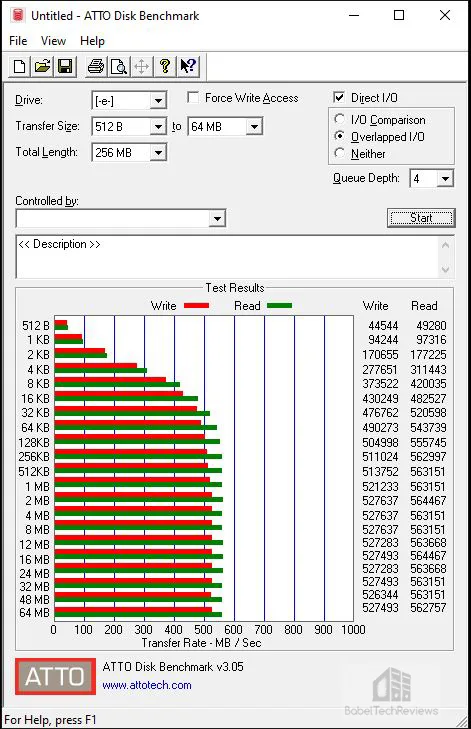
Here is the ATTO Team Group PD400 240GB SSD results:
The FireCuda 2 TB SSHD’s ATTO benchmark results are up last.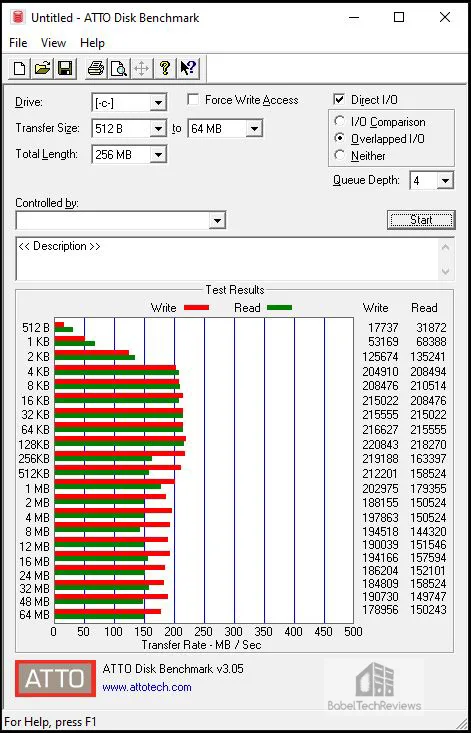
ATTO shows the NVMe SSDs with the CARDEA Liquid ahead of the A1000 are well ahead of the three other SATA III SSDs with the T-FORCE Vulcan 500GB SSD in second place followed by the DELTA MAX and then the LTE SSD followed more distantly by the external PD400 and then finally the SSHD which trails in every test.
HD Tach
HD Tach is a low level hardware benchmark for random access read/write storage devices including for SSDs and HDDs. HD Tach uses custom device drivers and low level Windows interfaces to determine the physical performance of the device. It is no longer supported and needs to be run in compatibility mode for Windows 7.
Here is the T-FORCE CARDEA Liquid 512GB SSD HDTach benchmark results with an average read of 1864.2MB/sec and a burst speed of 1936.1MHz.
 Here are the HD Tach Disk benches summarized in a chart comparing our six tested drives.
Here are the HD Tach Disk benches summarized in a chart comparing our six tested drives.
As usual, the PCIe M2 SSDs lead with the CARDEA Liquid well ahead of the Kingston A1000 which in turn is solidly ahead of the other SATA III SSDs; the T-FORCE Vulcan 500GB SSD is slightly faster than the DELTA MAX which is faster than the Team Group L5 LTE 480GB SSD which is in turn quicker than the PD400 USB portable SSD. The SSHD sits in last place.
File Copying
The CARDEA Liquid M.2 PCIe SSD is quite capable at copying files but it is inconsistent in its speeds for really large files. It took about 2 minutes to copy a 22.6GB Steam folder from program files to the desktop, but 10GB of the total was copied in less than 20 seconds.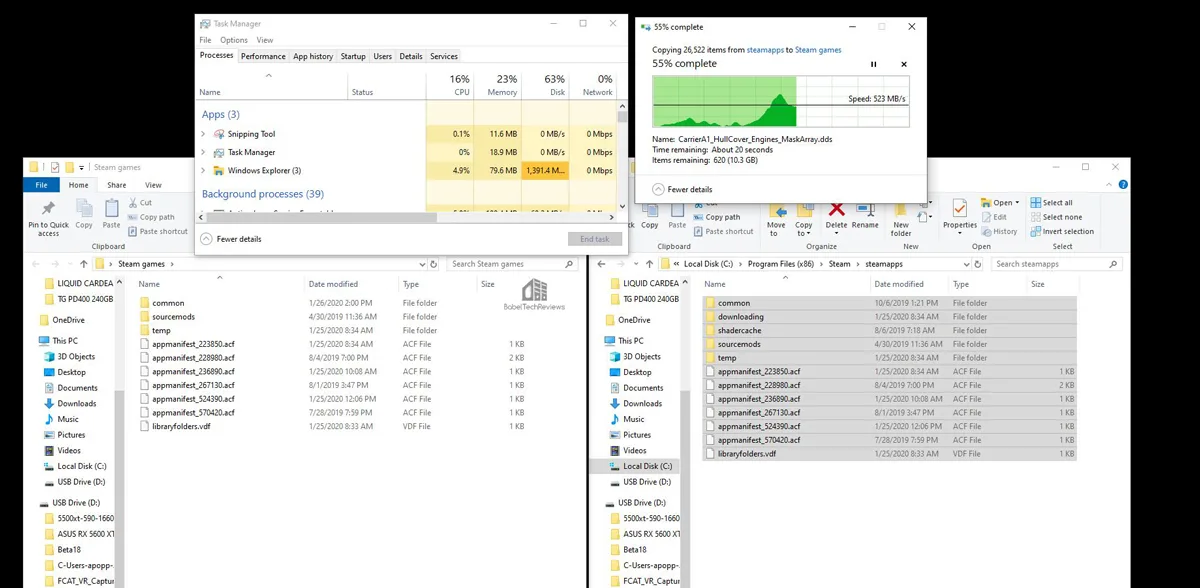
Let’s look at game and game level loading times next.
The Game/Level Loading Time Results
Game and game level loading time results are very difficult to measure precisely which is why we give the ultra-precise results using World of Warcraft and Battlefield 3 from PCMark 8. It is easy to see that generally SSDs perform similarly with regard to game loading times and they are miles ahead of any HDD. Even SSHDs require loading the same level or program over-and-over to get quicker.
 Even though the synthetic tests show the M.2 PCIe SSDs are much faster than SATA III or USB 3.1 SSDs, the actual loading time for two test games save only 2 to 5 seconds (over 1 to 2 minutes) between the fastest CARDEA Liquid and the slowest USB 3.0 SSD. In contrast, hard disk drives can take nearly twice as long to load a game compared with even the slowest SSD. And Solid State Hard Disks only take advantage of their hybrid status after multiple subsequent loadings of the same game or game level.
Even though the synthetic tests show the M.2 PCIe SSDs are much faster than SATA III or USB 3.1 SSDs, the actual loading time for two test games save only 2 to 5 seconds (over 1 to 2 minutes) between the fastest CARDEA Liquid and the slowest USB 3.0 SSD. In contrast, hard disk drives can take nearly twice as long to load a game compared with even the slowest SSD. And Solid State Hard Disks only take advantage of their hybrid status after multiple subsequent loadings of the same game or game level.
Until developers start to target SSDs for game storage, or perhaps after consoles move completely away from hard disk drives, we will probably no longer see SSDs held back from achieving the game loading performance that they are capable of. NVMe PCIe M.2 SSDs are a faster than SATA-based SSDs just as external USB 3.1 SSDs are generally a bit slower. The only reasons to recommend a HDD or SSHD over a SSD are based on high capacity and a lower cost per gigabyte for storage.
Here are all our other Summary Charts in one place for easy reference.
Non-Gaming Summary Charts
The T-FORCE CARDEA Liquid M.2 PCIe 512GB SSD is the most expensive as well as the fastest SSD that we tested by a large margin including over the other Kingston A1000 SSD which is considered entry level for a M.2 PCIe based SSD. Those who desire having the fastest PCs, will want a PCIe NVMe SSD for gaming while those who want to show it off will probably pick a RGB SATA SSD. Now a gamer doesn’t have to compromise as the CARDEA Liquid SSD is both fast and good looking.
We would recommend that gamers move from a HDD or a SSHD to any SSD including to an inexpensive USB 3.1-based SSD. The PD400 external USB 3.1 drive is faster than the SSHD although it is the slowest of our SSDs. All three of the SATA drives perform close to each other with the Vulkan being the fastest followed by the DELTA MAX and then the Team Group LTE SSD. The Kingston A1000 is an entry-level M.2 PCIe SSD while the T-FORCE CARDEA Liquid is quite fast with any price premium coming from being a completely unique liquid-filled showpiece.
The CARDEA Liquid M.2 PCIe SSD is incredibly fast for all day to day tasks. Windows 10 sets up and shuts down noticeably quicker than on any other SSD, and MS documents and apps open and save almost instantaneously. Copying large files are super quick, and Steam downloads no longer cripple productivity as with using a HD based PC.
CARDEA Liquid Temperatures and Liquid Cooling
After using the CARDEA Liquid M.2 PCIe SSD, we are still skeptical about the claims of liquid lowering temperatures by 10C with the current T-FORCE design. SSD flash memory only throttles above 80C which is a rare event in our experience. Secondly, the heat once transferred from the SSD to the water, can only use the surface of its plastic case to radiate heat once the water warms up. Thirdly, the SSD just doesn’t get hot enough to need liquid cooling. Putting the SSD under extreme load for over 10 minutes only caused the surface of its plastic case to rise to a maximum of 101.5F (38.6C).
In our opinion, the Liquid in the CARDEA SSD serves primarily for “looks” – and to be fair, Team Group has scored well there. This opinion is reinforced by the Safety Notices in the user manual: “3. The liquid cooling design can enhance the performance of a cooling system, but using the device without coolant liquid will not damage or burn the system. Please rest assured.”
However, we think that the CARDEA Liquid designers missed an opportunity to bat this design out of the park by using a liquid that boils at a low temperature coupled with an LED to light it up. We also think it is somewhat dangerous to use a liquid that conducts electricity that could leak onto the motherboard and damage it especially during the refilling process.
Let’s head for our conclusion.
The Conclusion & Verdict
SSD technology is still improving and again it seems that pricing is reasonable as SSD manufacturers seek to differentiate their SSDs from each other. The T-FORCE CARDEA Liquid M.2 PCIe SSD is a completely unique SSD that commands a premium price just by virtue of how it looks. It will appeal to a gamer that wants to make a M.2 PCIe SSD a visual showpiece for his PC. We are not certain of pricing because this SSD is out of stock everywhere we looked in the USA. Our best guess is the 512GB version is above $100 since the Kingston A2000 which replaces the A1000 is selling in the $80 to $90-plus range in the USA. [UPDATED at 6 AM PT on 01/30/20. MSRP of the 512GB version is $100.90 and $169.99 for the 1TB version.]
It is still not mandatory to have a SSD if you use your PC only for gaming. Games do not perform better on a SSD as developers still target the HDD for optimizing game performance which is why games load and play fine from a USB 3.0/3.1 SSD. However, many games may take significantly longer to load from a HDD or SSHD than they do from an external SSD. If a gamer wants to get right back into the game, a SSD will improve immersion and decrease frustration.
Windows 10 is becoming more and more painful to use when installed on a mechanical or even on a hybrid solid state/hard disk drive. Indexing, Search, or Anti-malware automatic programs may often saturate the bandwidth of a mechanical drive, and even downloading or updating Steam games may slow your PC to an irritating crawl.
Pros
- The CARDEA Liquid M.2 PCIe 512GB SSD is unique by virtue of its colored liquid design
- The CARDEA Liquid 512GB SSD is quite fast as a M.2 PCI2 SSD and sits well ahead of the Kingston A1000 M.2 PCIe SSD and considerably faster than any SATA III SSD
- It is not necessary to use the liquid to cool the SSD
- 5-year warranty backed by Team Group support
Cons
- The CARDEA Liquid SSD cooling aspect is in our opinion for show only
- Using a electrical conducting liquid may damage the motherboard if spilled
- The heatsink is warrantied for only 1 year
This has been quite an enjoyable exploration comparing our other six drives with the CARDEA Liquid M.2 PCIe SSD. We like its performance and will recommend it for a gamer that wants to feature a M.2 PCIe SSD as a visual showpiece.
The Verdict
We are giving the T-FORCE CARDEA Liquid M.2 PCIe SSD BTR’s “Innovation” Award even though the liquid is probably unnecessary and even potentially dangerous as a cooling solution. The CARDEA Liquid will probably appeal to a gamer that wants a completely unique look for his M.2 PCIe SSD without compromising on performance. We think it’s a good idea to develop something completely different as a M.2 PCIe SSD, and we hope that Team Group will bring out a CARDEA Liquid II design using improved lit visuals and with better cooling and safety features.
As a great-looking M.2 PCIe SSD, the CARDEA Liquid is an excellent way to store, launch, and play games while also being able to appreciate its completely unique visual appeal. We cannot return to using hard disk drives ever again for gaming and would recommend using a HDD or SSHD only for storage.
SSD prices change daily so we suggest checking for sales to get the best bang for buck. Despite our caveats, we can recommend the T-FORCE CARDEA Liquid SSD as a unique and good-looking choice for a fast M.2 PCIe SSD with a 5-year warranty backed by Team Group.
Happy Gaming!

